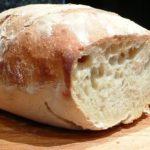6.8K
Basic White Bread – Recipe by James Beard
This recipe is James Beard’s classic white bread recipe. Once you master it you are good to go for bread. I did cut down the salt from 3 tsps to 1. – Jughandle
James Beard's Basic White Bread
Makes 1 large loaf or 2 small loaves This recipe called originally for 3 tsp of salt. A reader pointed out that 3 tsp is way too much so I cut it to 1 tsp. - jughandle
Servings 12 Servings
What You Will Need:
INGREDIENTS
- 1 yeast - package active dry
- 2 C water - Warm to 100-115 degrees F
- 2 tsp sugar - granulated
- 4 C all purpose flour - approx. 1 lb
- 1 Tbsp salt
- 2 Tbsp butter - Softened for buttering bowl and pan
Method:
- In a small bowl mix the yeast and the 1/4 cup warm water; add the sugar, stir well, and set aside until proofed.
- It is proofed when fermentation is apparent: the mixture will swell and small bubbles appear on the surface. (If it doesn't proof at all, it means the yeast is not fresh or it is dead.)
- In a small saucepan heat the milk with the salt and stir in the butter until it melts. Set aside to cool until it is no warmer than the yeast mixture.
- Put 2 cups of the flour in a large mixing bowl and stir in the milk mixture. Beat well with a wooden spatula, add the yeast mixture, and continue beating the dough until it is smooth, adding an additional cup of flour to make a firm dough.
- Turn the dough out onto a floured work surface and begin the kneading process, which evenly distributes the fermenting yeast cells through the dough.
- There are several kneading methods, but the basic one is to flour the dough and your hand lightly, then push the heel of your hand down into the dough and away from you. Fold the dough over, give it a quarter turn, and push down again. Repeat pushing, folding and turning until the motion becomes rhythmic.
- Knead for about 10 minutes, kneading in additional flour as necessary, until the dough is smooth and no longer sticky, and blisters form on the surface.
- To test whether the dough has been kneaded enough make an indention in it with your fingers; it should spring back. If blisters form on the surface of the dough and break, this is another sign that the kneading is sufficient.
- * Note: If you have a heavy-duty electric mixer with a dough-hook attachment, knead the dough with the hook and finish it off on the board.
- Butter a large bowl, transfer the dough to it, and turn the bowl until the dough is well coated with butter on all sides. Cover the dough with a dish towel and let it rise in a warm, draft-free place for 1 to 1-1/2 hours, until it is doubled in bulk. A good, warm, draft-free place is inside your room temperature oven.
- To test further if the dough has risen properly, make an indentation in it with two fingers: if the dough does not spring back, then it is ready.
- Butter a 9x5x3 inch loaf pan, or two pans that are about 8x4x2 inches. Punch the dough down with your fist to deflate it; transfer it to a floured board and knead it well for about 3 minutes. Pat it into a smooth round or oval shape and let it rest for 4 to 5 minutes.
- Then form into 1 large or two small loaves, by shaping the dough into an oval the length of your bread pan, then gently stretching, rounding, and plumping it in the palms of your hands, tucking the edges underneath and pinching them together.
- Lift carefully; drop the dough into the pan or pans and smooth out. Cover the dough with a towel and let it rise again in a warm draft-free place for about 45 minutes to 1 hour, until it is double in bulk.
- Preheat the oven to 400 d F. Brush the egg wash over the top of the dough.
- Bake in the center of the oven for 20 minutes; reduce the heat to 350 d F and bake for 20 to 25 minutes longer, until the crust is well browned and the bread sounds hollow when removed from the pan and tapped on the bottom with the knuckles.
- If you like a crusty loaf, remove it from the pan about 5 to 10 minutes before the end of the baking time and let it finish baking on the oven rack. It will get brown and crusty all over.
Notes
* Note: If you have a heavy-duty electric mixer with a dough-hook attachment, knead the dough with the hook and finish it off on the board. Remove the bread from the oven and let it cool on a rack before slicing.The bread may be stored in a plastic bag in the refrigerator after it has cooled. If you seal it in a bag before it is completely cooled, the crust will become soft. Stored bread will keep about 1 week. It also freezes well if wrapped tightly in plastic wrap and sealed in a plastic bag and can be kept for up to 3 months.
Nutrition
Nutrition Facts
James Beard's Basic White Bread
Amount Per Serving
Calories 171
Calories from Fat 18
% Daily Value*
Fat 2g3%
Saturated Fat 1g6%
Cholesterol 5mg2%
Sodium 601mg26%
Potassium 44mg1%
Carbohydrates 32g11%
Fiber 1g4%
Protein 4g8%
Vitamin A 60IU1%
Calcium 8mg1%
Iron 1.9mg11%
* Percent Daily Values are based on a 2000 calorie diet.


